Seaweed
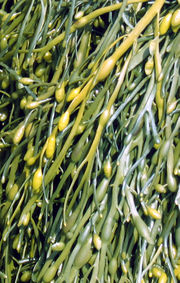
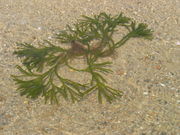
Seaweed is a loose, colloquial term encompassing macroscopic, multicellular, benthic marine algae.[1] The term includes some members of the red, brown and green algae. Seaweeds can also be classified by use (as food, medicine, fertilizer, industrial, etc.).
Contents |
Taxonomy
A seaweed may belong to one of several groups of multicellular algae: the red algae, green algae, and brown algae. As these three groups are not thought to have a common multicellular ancestor, the seaweeds are a polyphyletic group. In addition, some tuft-forming bluegreen algae (Cyanobacteria) are sometimes considered as seaweeds — "seaweed" is a colloquial term and lacks a formal definition.
Structure
Seaweeds' appearance somewhat resembles non-arboreal terrestrial plants.
- thallus: the algal body
- lamina: a flattened structure that is somewhat leaf-like
- sorus: spore cluster
- on Fucus, air bladders: float-assist organ (on blade)
- on kelp, floats: float-assist organ (between lamina and stipe)
- stipe: a stem-like structure, may be absent
- holdfast: specialized basal structure providing attachment to a surface, often a rock or another alga.
- haptera: finger-like extensions of holdfast anchoring to benthic substrate
- lamina: a flattened structure that is somewhat leaf-like
The stipe and blade are collectively known as the frond.
Ecology
Two specific environmental requirements dominate seaweed ecology. These are the presence of seawater (or at least brackish water) and the presence of light sufficient to drive photosynthesis. Another common requirement is a firm attachment point. As a result, seaweeds most commonly inhabit the littoral zone and within that zone more frequently on rocky shores than on sand or shingle. Seaweeds occupy a wide range of ecological niches. The highest elevation is only wetted by the tops of sea spray, the lowest is several meters deep. In some areas, littoral seaweeds can extend several miles out to sea. The limiting factor in such cases is sunlight availability. The deepest living seaweeds are the various kelps.
A number of species such as Sargassum have adapted to a fully planktonic niche and are free-floating, depending on gas-filled sacs to maintain an acceptable depth.
Others have adapted to live in tidal rock pools. In this niche seaweeds must withstand rapidly changing temperature and salinity and even occasional drying.[2]
Uses

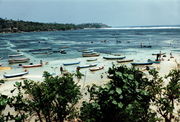
Seaweed has a variety of purposes, for which it is farmed[3] or foraged from the wild.[4]
Food
Seaweeds are consumed by coastal people, particularly in East Asia, e.g., Japan, China, Korea, Taiwan, Thailand, Cambodia, and Vietnam, but also in Indonesia, Belize, Peru, Chile the Canadian Maritimes, Scandinavia, Ireland, Wales, Philippines, and Scotland. Tiwi, Albay residents discovered a new pancit or noodles made from seaweed, which has health benefits. It is rich in calcium, magnesium and iodine, and seaweed noodles can be cooked into pancit canton, pancit luglug, spaghetti or carbonara.[5]
In Asia, Zicai (紫菜) (in China), gim (in Korea) and nori (in Japan) are sheets of dried Porphyra used in soups or to wrap sushi. Chondrus crispus (commonly known as Irish moss or carrageenan moss) is another red alga used in producing various food additives, along with Kappaphycus and various gigartinoid seaweeds. Porphyra is a red alga used in Wales to make laver. Laverbread, made from oats and the laver, is a popular dish there. Affectionately called "Dulce" in northern Belize, seaweeds are mixed with milk, nutmeg, cinnamon, and vanilla to make a common beverage.
Seaweeds are also harvested or cultivated for the extraction of alginate, agar and carrageenan, gelatinous substances collectively known as hydrocolloids or phycocolloids. Hydrocolloids have attained commercial significance as food additives.[6] The food industry exploits their gelling, water-retention, emulsifying and other physical properties. Agar is used in foods such as confectionery, meat and poultry products, desserts and beverages and moulded foods. Carrageenan is used in salad dressings and sauces, dietetic foods, and as a preservative in meat and fish products, dairy items and baked goods.
Medicine
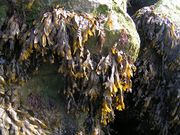
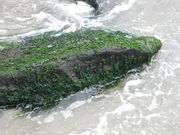
Alginates are used in wound dressings, and production of dental moulds. In microbiology research, agar is extensively used as culture medium.
Seaweed is a source of iodine,[7] necessary for thyroid function and to prevent goitre. Excess intake of seaweed may raise iodine to toxic levels, however.
Seaweeds may have curative properties for tuberculosis, arthritis, colds and influenza, worm infestations and even tumors.[1]
Seaweed extract is used in some diet pills.[8][9][10] Other seaweed pills exploit the same effect as gastric banding, expanding in the stomach to make the body feel more full.[11][12]
Other uses
Other seaweeds may be used as fertilizer. Seaweed is currently under consideration as a potential source of bioethanol.[13][14] Seaweed is an ingredient in toothpaste, cosmetics and paints.[3]
Alginates enjoy many of the same uses as carrageenan, and are used in industrial products such as paper coatings, adhesives, dyes, gels, explosives and in processes such as paper sizing, textile printing, hydro-mulching and drilling.
Health risks
The high iodine content of seaweed can produce iodine toxicity if large amounts of seaweed are consumed.
Rotting seaweed is a potent source of hydrogen sulfide, a highly toxic gas, and has been implicated in some incidents of apparent hydrogen-sulfide poisoning.[15] It can cause vomiting and diarrhea.
See also

- Algaculture
- Algal fuel
- Kelp
- Ogonori
- Sea lettuce
- Seaweed dermatitis
- Wakame
- Seaweed genera
- Caulerpa
- Fucus
- Gracilaria
- Laminaria
- Macrocystis
- Monostroma
- Porphyra
References
- ↑ Smith, G.M. 1944. Marine Algae of the Monterey Peninsula, California. Stanford Univ., 2nd Edition.
- ↑ Lewis, J.R. 1964. The Ecology of Rocky Shores. The English Universities Press Ltd.
- ↑ 3.0 3.1 "Seaweed farmers get better prices if united". Sun.Star. 2008-06-19. http://www.sunstar.com.ph/static/dav/2008/06/19/bus/seaweed.farmers.get.better.prices.if.united.jica.html. Retrieved 2008-07-16.
- ↑ "Springtime's foraging treats". Life and Health, Guardian.co.uk. The Guardian. 2007-01-06. http://lifeandhealth.guardian.co.uk/guides/freestuff/story/0,,1981372,00.html. Retrieved 2008-07-16.
- ↑ "Albay folk promote seaweed ‘pansit’". ABS-CBN Regional Network Group. 2008-04-08. http://www.abs-cbnnews.com/nation/regions/04/08/08/albay-folk-promote-seaweed-pansit. Retrieved 2009-08-04.
- ↑ Round F.E. 1962 The Biology of the Algae. Edward Arnold Ltd.
- ↑ Iodine in Seaweed
- ↑ http://www.timesonline.co.uk/tol/life_and_style/food_and_drink/article2472720.ece
- ↑ Maeda, H; Hosokawa, M; Sashima, T; Funayama, K; Miyashita, K (Jul 2005). "Fucoxanthin from edible seaweed, Undaria pinnatifida, shows antiobesity effect through UCP1 expression in white adipose tissues". Biochemical and biophysical research communications 332 (2): 392–7. doi:10.1016/j.bbrc.2005.05.002. PMID 15896707.
- ↑ http://www.dailymail.co.uk/health/article-1134430/So-diet-pills-CAN-trim-tum-Our-expert-brands-test.html?ITO=1490
- ↑ http://www.foxnews.com/story/0,2933,476766,00.html?sPage=fnc/health/nutrition
- ↑ http://news.softpedia.com/news/Appesat-the-Seaweed-Diet-Pill-that-Expands-in-the-Stomach-101227.shtml
- ↑ Ireland Taps New Energy Source : Discovery News : Discovery Channel
- ↑ Seaweed Biofuels: Production of Biogas and Bioethanol from Brown Macroalgae
- ↑ "Algues vertes: la famille du chauffeur décédé porte plainte contre X" AFP, retrieved 2010-04-22 (in French)
External links
- Michael Guiry's Seaweed Site, information on all aspects of algae, seaweeds and marine algal biology
- AlgaeBase, a searchable taxonomic, image, and utilization database of freshwater, marine and terrestrial algae, including seaweed.
- SeaweedAfrica, information on seaweed utilisation for the African continent.
- Seaweed Malaysia Site, information on seaweed nutrition, facts and information for human health.